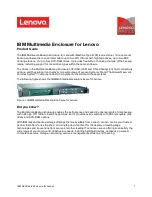
103
APPENDIX
and that location will be tested by the drive to be certain the
location is not defective. If it is found to have a defect, data will
be automatically relocated, and the defective location is mapped
out to prevent future write attempts.
In the event of an unrecoverable read error, the error will be
reported to the host and the location will be flagged as being
potentially defective. A subsequent write to that location will
initiate a sector test and relocation should that location prove to
have a defect. Auto Reassign Sector does not affect disk storage
performance because it runs as a background task. Auto Reas-
sign Sector discontinues when the operating system makes a
request.
• Consistency Check
A consistency check is a process that verifies the integrity of
redundant data. To verify RAID 3, 5, 6, 30, 50 or 60 redundan-
cy, a consistency check reads all associated data blocks, com-
putes parity, reads parity, and verifies that the computed parity
matches the read parity.
Consistency checks are very important because they detect and
correct parity errors or bad disk blocks in the drive. A consis-
tency check forces every block on a volume to be read, and any
bad blocks are marked; those blocks are not used again. This
is critical and important because a bad disk block can prevent a
disk rebuild from completing. We strongly recommend that you
run consistency checks on a regular basis—at least once per
week. Note that consistency checks degrade performance, so
you should run them when the system load can tolerate it.
Data Protection
• Battery Backup
The RAID controllers are armed with a Battery Backup Module
(BBM). While a Uninterruptible Power Supply (UPS) protects
most servers from power fluctuations or failures, a BBM provides
an additional level of protection. In the event of a power failure,
a BBM supplies power to retain data in the RAID controller’s










































